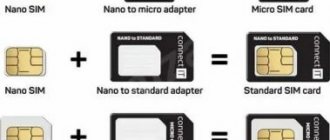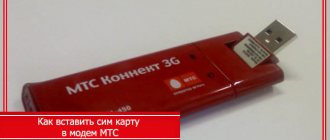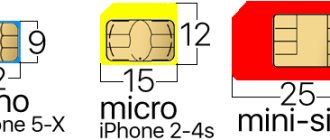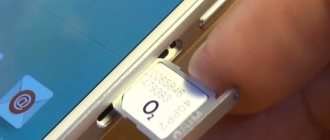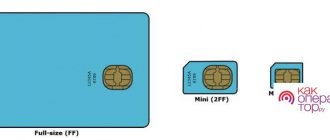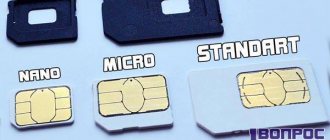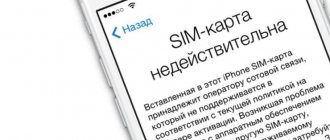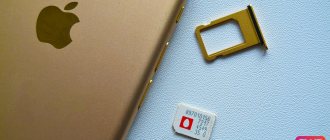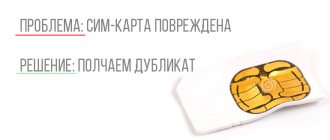Nano-SIM is a miniature version of a standard SIM card. The same SIM card, just in a smaller size. Previously it was longer and wider. Now the plastic edges have been removed. In 2021, nano SIM cards are used in many mobile devices.
You can see what a nano-SIM looks like in the photo:
The nano SIM card size is as follows.
- Length 12.3 mm,
- Width 8.8 mm.
Sizes vary depending on the campaign, but not much.
Peculiarities
There were no special innovations in the chip:
- The size has decreased.
- Excess plastic was removed to reduce weight.
- Essentially this is a copy of micro.
What is a Micro Sim card?
Functionally, such cards do not differ from the previous generation, because their main part (chip) remains the same size, only the amount of plastic around this main element has decreased. But from a marketing point of view, these SIMs represent a real revolution. Due to the fact that the plastic part was reduced, its dimensions were 15x12x0.76 mm.
Such cards began to be widely used by Apple in the iPhone 4 model. The small size of the card allowed them to save space inside the smartphone, so the idea of using SIMs was picked up by other smartphone developers. And now this type of card is the most common.
Differences from micro-SIM cards
The question “Which type of SIM card is better?” should not be in front of the user. NanoSIM differs from its predecessor only in dimensions. Technical specifications, including communication standard support and number storage capacity, remain unchanged. But it is important to understand that chips change every year. Therefore, timely replacement of the card allows you not only to avoid damage to the device, but also to obtain advanced functions.
For example, many clients of mobile operators complain that their phone does not receive 4G, although this feature is present in the technical specifications. The problem does not arise from the fact that a person uses MicroSIM instead of NanoSIM, but from the date of purchase of the device. Chips released before 2013 cannot, a priori, support fourth generation networks. In this regard, we must once again advise you to replace the card if it was purchased a very long time ago.
How to change SIM size?
You can get a new card from your operator, contact a service center, or reduce its size yourself. cut it yourself to nano as carefully as possible so as not to damage the chip.
Contact your mobile operator
You need to visit your operator’s communications office with your passport and smartphone and order a replacement SIM card. It can be carried out on the day of application, while the mobile phone number, balance and activated services will be preserved.
Telecom operators have now started offering SIMs that can be used in all types of smartphones. Their main shell is “mini”, from which “micro” or “ nano ” can be squeezed out along the dotted line.
Contact the service center
If you don’t have time to wait for the operator to make a new card , contact a service center that specializes in repairing smartphones and other equipment.
Reducing a SIM card to the required size is done using a device similar to a stapler. One click and the excess plastic is cut off.
Replacement in the operator's cabin
Where can I change my SIM card? This can be done in the operator’s salon, and completely free of charge. In this case, all information, phone number, account and connected options will be saved. When contacting a communication salon, you need a passport and an old card issued in the name of the owner.
To change your Tele2 SIM card, you will need to pay a small amount of money, which will remain in your account. In a day, the old card will no longer function. Replacing MTS or Beeline is absolutely free and takes a minimum of time. The same thing happens when replacing a Megafon card.
This method is safe and does not require much time. It is needed in order to save all the necessary data on the SIM card, because if you change the size yourself, the chip may be damaged, and it will no longer be possible to use the card.
How to make nano from micro?
To do everything correctly, trimming must be done carefully without damaging the chip. You must first prepare:
- Double sided tape;
- SIM standard size or “micro”;
- Sheet of paper, printer;
- Pencil, ruler, scissors;
- Sandpaper (grain size below medium).
Regardless of where the SIM card will be used in the future, the sequence of actions when reducing it will not change. In order not to cut off excess and damage the circuit, we use a SIM card template. Download it on the Internet. Now carefully:
- Print out the downloaded template on a piece of paper. The picture must be clear.
- Using scissors, cut out the template.
- Place double-sided tape on the back of the card .
- We paste the template on top of the tape so that it does not go over the edges of the microcircuit.
- We cut off the excess plastic along the contour of the template. The scissors must be sharp; if not, you can use nail clippers.
- Remove the double-sided tape from the SIM card and you can insert it into the gadget.
If the cut line runs next to the chip, then this will not affect the operation of the card. Use sandpaper to round the edges of the card and remove any rough edges from the plastic.
Micro-SIM and nano-SIM: the difference is in the size of the plastic or in the chip?
Based on the above characteristics of SIM cards, you can notice a significant reduction in plastic, directly along the edges of the SIM card chip. The dimensions of SIM cards are the key and main feature of what the SIM card is called. This size only affects the plastic; there are no and cannot be any changes in the chip itself. You can use a regular SIM card (mini-SIM), and if you update your smartphone to a newer model that requires a micro-SIM, you can change it to the desired size at any time, be it micro-SIM or nano-SIM.
What's next?
SIM cards , which are literally 1 mm larger than the dimensions of the chip, have been used in smartphones and tablets for several years. Further reduction in size will make it impossible to use such microcircuits. Therefore, the new stage will be the transition to e- SIM, or developers will use built-in cards .
The peculiarity of e-SIM technology is that even at the production stage a separate microcircuit will be built into the gadget. The mobile operator will provide the subscriber with information that must be entered into the gadget to identify it. After entering this information, it is recorded in the microcircuit, and it acts as a SIM card. The difference with cards of this type is that you don’t need to cut anything off or worry if the developers release something in a new format.
Differences and differences between micro SIM and nano SIM cards
Rating 4.5/5 (2 votes)
Types of SIM cards
Today there are only 3 types of SIM cards, these are:
- Mini-SIM
- Micro-SIM
- Nano-SIM
Mini - sim is an ordinary and familiar SIM card, standard size, which is usually called a “SIM card”, without the “mini” prefix. The most common format of SIM cards, but today they are increasingly difficult to find in new flagship smartphone models. The size of a regular, standard SIM card or mini-sim is 25 X 15mm
Micro - sim is the same SIM card as a mini-sim, but unlike it, a micro-sim has a smaller size of 15 X 12mm. As a rule, SIM cards are sold with the ability to turn a regular SIM card into a micro-SIM card by simply squeezing a micro-SIM out of the card’s plastic frame.
A universal or multi-SIM card looks like this (you can see the boundaries along which you need to squeeze out the required SIM card size):
The well-deserved glory of the apple
In our country, most people learned about Apple in 2007, after the presentation of the very first iPhone:
- It was the corporation's first smartphone;
- The telephone was far ahead of its time;
- The average user has never encountered anything like this before;
- The touch screen turned out to be a real breakthrough in matters of mobile technology;
- Almost a decade later, the company is still setting trends in the mobile device market.
And although the profit and capitalization of the corporation is growing every year, evil tongues are already predicting its imminent collapse. After all, Apple hasn’t given the world anything radically new in recent years, and you can’t go far on its former glory. Without another breakthrough, over time, we will get another company that produces good phones. But nothing more.
The next stage will probably be the development of holographic projections or the introduction of mobile systems directly into the brain. But now all this looks like a distant futuristic future that has nothing in common with current reality.
Facts about MicroSD
MicroSD memory card format
- historically one of the earliest in the line of SD standards (or Secure Digital - its creation was the result of further development and improvement of the MMC flash memory standard). MicroSD cards have found the widest use among users of PCs, smartphones, tablets, photo and video cameras.
The maximum capacity of MicroSD cards is 2 GB. The standard size of products of this type is 11 by 15 mm with a thickness of 1 mm. The maximum speed for writing and reading data on a card of the appropriate type is 25 MB/s.
Hand cutting
If the previous two methods are not available to you, you can cut out the SIM card yourself. To do this, you will need a nano-sim template or drawing showing how much to trim the plastic edges around the chip.
It’s easy to get a new SIM card, all operators have already adapted to providing nano-SIM, and now everyone can get it quickly and for free . This SIM card will help reduce the weight of the smartphone and make it more compact.
PIN [edit | edit code]
When a SIM card is issued, it is assigned a four-digit digital PIN code, which is recorded on the card and also transmitted to the subscriber along with the card.
If you enable the corresponding option, the PIN code will be requested by the phone every time you turn it on in order to access the data on the SIM card. In the 2010s, the option is disabled by default in most manufactured SIM cards.
If the PIN code is entered incorrectly three times in a row, the card is blocked and can only be unblocked by entering the personal unlocking code PUK1 ( PIN Unblocking Key
), which is also transmitted to the subscriber along with the card. If the PUK code cannot be entered correctly after ten attempts, the SIM card is completely blocked and needs to be replaced [6]. Using the PUK code, the user can also change the PIN code [7] .
Some SIM cards have a second set of PIN codes: PIN2 and PUK2 to work with several additional services.
If the SIM card is not installed in the phone or if the correct PIN code is not entered, the phone cannot make any calls on the cellular network, with the exception of emergency calls (number 112 or 911). All other functions of classic phones are usually blocked, but smartphones and communicators are able to work in such conditions.
Criticism [edit | edit code]
Data recovery [edit | edit code]
Data (contact numbers, SMS messages, etc.) stored on the SIM card is processed via the phone. However, when this data is deleted via the phone, it is not completely deleted, but is only marked as deleted, which means it can be recovered [12] . To recover deleted data (as well as completely delete it) from a SIM card, there is specialized software, for example, Device Seizure [13] from Paraben Corporation [14].
Vulnerabilities [edit | edit code]
In 2011, Security Research Labs, led by Karsten Nohl, began testing the security of SIM cards. The result of two years of work was the identification of a vulnerability in SIM cards based on the outdated DES crypto-algorithm, due to which it is possible to gain full access to the contents of the SIM card. On this research, on July 31, 2013, Karsten Nohl presented his report at the BlackHat conference [15].
Types of SIM cards
The SIM card is an identification module that is used in the GSM network. Its function is to store unique information about the account, thanks to which subscribers can change mobile devices while maintaining unique data - phone book, messages, incoming and outgoing calls.
SIM cards for mobile phones are usually classified by size:
How to determine which one you need
When installing a new SIM card into a gadget, you need to know what card format it supports. The necessary information is indicated in the manual for the mobile device, as well as on the website of the manufacturer of this phone model.
- Mini cards are used in all phone models that were released between 2000 and 2003;
- Since the beginning of 2003, phones have entered the market that began to use Micro cards. In smartphones with two SIM cards, in most cases there are two slots: the first is Mini and the second is Micro;
- The Nano card format became widely used in early 2012 after the release of the iPhone 5. These cards are not only smaller, but also significantly thinner than the previous two.
The miniaturization of SIM cards has allowed manufacturers to produce gadgets and devices with less thickness and weight. Thanks to their appearance, modern phones do not look bulky.
